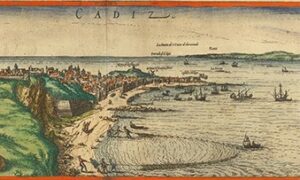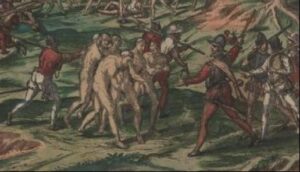The Niña and India arrived at Cádiz on June 11, 1496 (528 years ago). By chance, three caravels then were ready to depart Cádiz, bearing fresh supplies and Queen Isabella and King Ferdinand’s most recently prepared letters for Columbus in “Española,” which Columbus quickly read. The letters included Isabella and Ferdinand’s confirmation that “Indians” forcefully resisting their conquest could be enslaved as “war captives.”
Over a year earlier, Isabella and Ferdinand had responded to Columbus’s repeated requests for approval of a general slave trade in Indians by deferring an answer—indicating that they wanted learned men, theologians, and lawyers to advise if Indians could be sold into slavery but permitting sales of Indians he’d then sent to Spain on a contingent basis while the determination was made (Indians so sold would be manumitted if enslavement subsequently was determined unlawful). See the post of April 16, 2023, at isabella-and-ferdinands-1495-decision-on-indian-enslavement/.
As depicted in Columbus and Caonabó: 1493–1498 Retold, before leaving Cádiz that June, Columbus promptly prepared and dispatched instructions on the departing caravels to his brother Bartolomé—then governing Española in Columbus’s absence—directing the enslavement and transport to Spain of Indians captured in hostilities. Upon receipt of Columbus’s letter in July, within weeks Bartolomé slave raided three hundred Taínos he claimed were such, and on September 29, dispatched them back to Spain for sale in Andalusia.
The next sequel will depict Isabella’s well-known decree of June 20, 1500, that Indians who’d been brought from the Indies and sold in Seville and Andalusia on Columbus’s command were to be freed, as well as Isabella’s orders to the governors that succeeded Columbus prohibiting enslavement of non-resisting Indians. But enslavement of Indians “resisting conquest” remained permitted and, as the sequel will depict, Bartolomé was but one of many explorers and territory governors who thereafter justified enslavements simply by asserting that those whose homeland they invaded had resisted.
The following portions of engravings (included in Columbus and Caonabó) depict the harbor at Cádiz in the sixteenth century (Georg Braun and Frans Hogenburg, Civitates Orbis Terrarum, 1572–1617) and slave raiding (Theodor de Bry, 1595, courtesy of the John Carter Brown Library, portion of rec. no. 34724-5).


